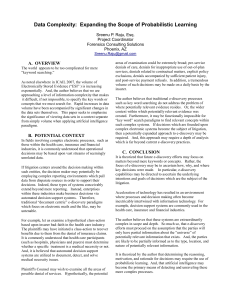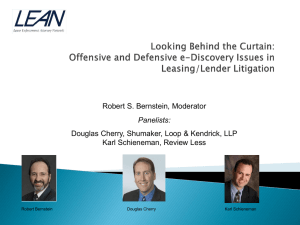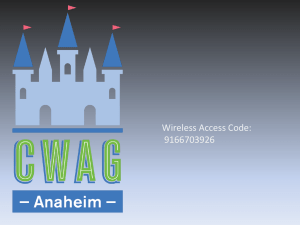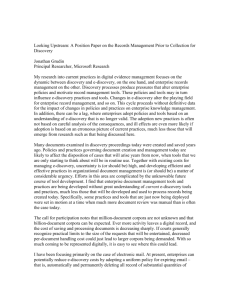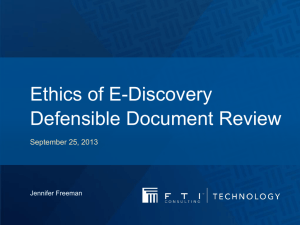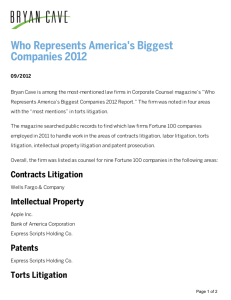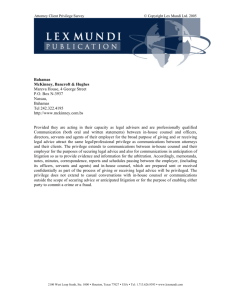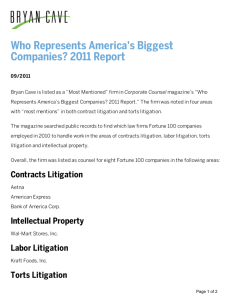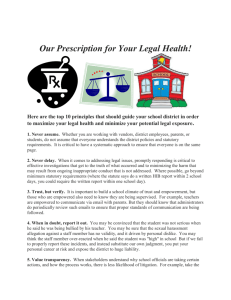with E-Discovery - Association of Corporate Counsel
advertisement
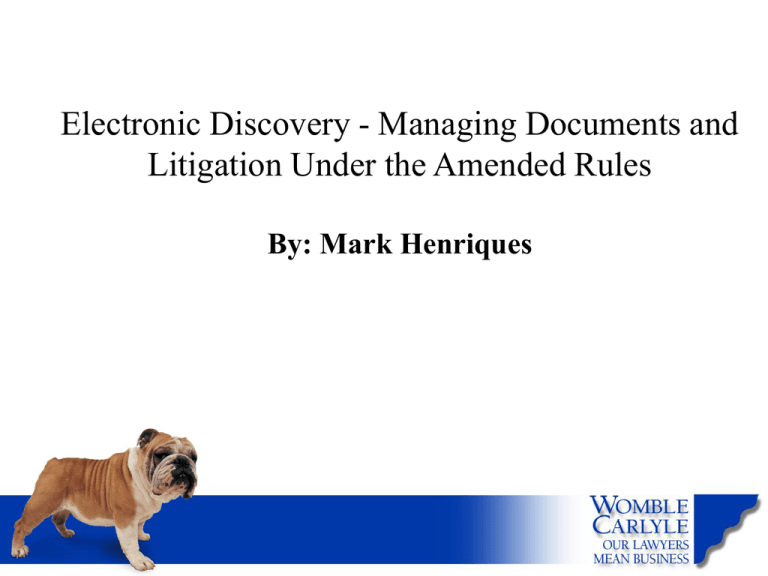
Electronic Discovery - Managing Documents and Litigation Under the Amended Rules By: Mark Henriques Hypothetical Ms. Hernandez sues Carolina Service Company (“CSC”) for employment discrimination. She is a 55 year old hispanic female. CSC receives a discovery request for all documents relating to Ms. Hernandez’ employment. What does CSC produce? 1965 Traditional paper documents. 1975 Traditional paper documents, PLUS data compilations (for example, print outs from a computer). Today Traditional paper documents, data compilations, PLUS e-mails, Excel spreadsheets, metadata and other information that might have never been reduced to paper. Document Creation – 1990 versus 2008 Electronic 10% Paper 7% 93+% electronic form only! 1990 Paper 90% 2008 Electronic 93% Where do we look for guidance: • • • • Sedona Conference Judge Scheindlin’s Zebulake opinions Advisory Committee Report Recent Case Law / Reporters Managing E-Discovery is crucial: • Most new cases will involve e-discovery. • Almost all newly created information is stored electronically. • Expensive and time consuming, but potential source of key discovery. Back to the hypothetical . . . • Under the Rules, before discovery requests are propounded: - Lawyer consults with IT. - Lawyer meets with opposing counsel. IT Meeting • Lawyer must obtain information about: - Servers. - Back up systems and tapes. - Storage devices (Palm Pilots, Treos, Thumb Drives, Laptops, etc.). - E-mail retention. Network Data Retention Architecture Yahoo Email Account AOL Email Account PCs with Outlook Local Server Local Server Local Server IBM Compatible J Kinsel Laptop Exchange 5.5 M Ferrario Laptop J Kurz Laptop IBM Compatible IServer C Email Server IBM Compatible Workstation Workstation IBM AS/400 Virginia Data Center Disk array IBM AS/400 Disk array Honolulu Mirror Center Litigation Off Switch Immediate stop of the deletion of email and other electronic documents Identify the KEY PLAYERS at CSC . . . We’re meeting with them on Day 1! The Litigation Holds begins with their e-mails, documents and data. Timeline under FRCP Amendments Scheduling Order may include: First 90-120 days after Service modifications of the times for disclosures under Rules 26(a) and 26(e)(1) and of the extent of discovery to be permitted; Complaint Served Rule 26(f) Meet and Confer (5) provisions for disclosure or discovery of electronically stored information; Form 35 Report (6) any agreements the parties reach for asserting claims of privilege or protection as trial-preparation material after production; RULE 16(b) The order shall issue as soon as possible but in any event within 90 days after the appearance of a defendant and within 120 days after the complaint has been served on a defendant. Report of Planning Meeting Rule 16(b) Scheduling Conference (7) (8) Rule 26(a)1) Initial Disclosures and Discovery Rule 26(f) – Meet and Confer The Three “P”s • Preservation of electronic information. • Production of electronic information. • Privilege issues. Topics to Discuss • • • • • • • Topics for such discovery. Time period for electronic discovery. Various sources of each party’s electronic data. Reasonable accessibility of such information. Form of production. Preservation of electronic information. Privilege issues relating to such data. Company Data Systems (from Convera website) Office Documents File Systems Groupware Servers Document Management Databases Multimedia Scanned Materials Intranets/Internet Expert Systems and more . . . After Meet and Confer, present suggestions to Judge at scheduling conference. Rule 16(b) Order • May include e-discovery agreements. • Helpful to avoid delay and excessive cost. • Provisions for disclosure or discovery of electronically stored information. • Any agreements the parties reach for asserting claims of privilege or of protection as trial-preparation. Agreements to consider include: • Clawback Agreements • Quick Peek Agreements Clawback Agreement • An agreement that inadvertently produced privileged material will be returned without asserting waiver. • Pitfalls. Quick Peek or “Sneak Peek” • Allows review of data before privilege review. • After items are selected, they are reviewed for privilege. • Agreement that initial production does not waive privilege. • Pitfalls. Also consider including: • Preservation issues. • Search terms. • Plans to share or reduce costs. Back to the hypothetical . . . Ms. Hernandez worked at the company for 5 years: - E-mails on back up tapes. - Files on obsolete computers. - Box of floppy disks. - Old desktop/laptop. Email Production Options (not including privilege search/ assumes keyword relevancy search) Active Files – July 2004 to Present $50K Archived files – Jan 2002- June 2004 Option A – Quarterly tapes 80-85% $73K/year $182.5K Option B – Monthly Tapes 91-95% $158K/year $395K $500K/year $1.5MM Legacy files – 1999-2001 Option A – Quarterly tapes 80-85% Reasonably Accessible Data If data is not reasonably accessible, burden shifts to requesting party. Need to show good cause because benefits outweigh costs. Attorney for CSC will want to: • Determine if reasonably accessible. • If not, identify sources not being searched. • Continue to preserve. To determine if data is “reasonably accessible”: • Conduct sampling of information. • Depose IT person. • Allow Court or third party inspection. Parties then need to discuss: • The costs and burdens of accessing the data; • The needs that may establish “good cause” for accessing the data if it is not reasonably accessible; and • Potential conditions on obtaining and producing the information. Factors to determine “good cause”: • Specificity of the document request. • Quantity of information available from other and more easily accessed sources. • Failure to produce relevant information that seems likely to have existed but no longer available on more easily accessed sources; • Likelihood of finding relevant, responsive information that cannot be obtained from other more easily accessed sources; • Predictions as to the importance and usefulness of the further information; • The importance of the issues at stake in the litigation; and • The parties’ resources. Back to the hypothetical . . . • Producible data identified. • Next, must decide the form of production: - Native - Paper - TIFF files - Interactive Amendments to Rules 33(d) and 34 • Requesting party may specify the format. • If no format specified, production should be in the format in which the data is ordinarily obtained or is reasonably useable. Production buzzwords: • Legacy data • Metadata Privilege Issues • The party making the claim may notify any party that received the information of the claim and the basis for it. • After being notified, a party must promptly return, sequester, or destroy the specified information and any copies it has and may not use or disclose the information until the claim is resolved. • A receiving party may promptly present the information to the court under seal for a determination of the claim. Recent Ruling: May 29, 2008 • Victor Stanley v. Creative Pipe Originally a paper production • Court ordered forensic experts to devise search: came up with 5 pages of search terms • 165 privileged docs missed in review • Too Bad! Warning: Rule 26(b)(5) does not change the substance of current privilege law. Proposed FRE 502 would address this issue. Rule 45: E-discovery changes also apply to non-parties: • A subpoena may now “command each person to whom it is directed to attend and give testimony or to produce and permit inspection, copying, testing or sampling of designated books, documents, electronically stored information, or tangible things . . .” • A subpoena may also “specify the form or forms in which electronically stored information is to be produced.” Rule of Thumb for Production Format • Hard copy (paper) documents – single page TIFF or pdf files. • Electronic data – Native format with all metadata. E-Mail Options: Form Problems Hard copy print out No Metadata Single page TIFF Loses connection with attachments Native Privilege and redaction; bates numbering difficulties Native .pst production favored by some courts: • Verisign: .pst produces in ordinary course of business. • CP Solutions: .pst to maintain connections with attachments. Excel Spreadsheets • Excel spreadsheets are created to be “active” – with cells that can be manipulated, calculated and sorted. • Static TIFF or hard copy production disables this interaction. • Williams: Improper to lock cells and scrub metadata. Is the format searchable? • TIFFs on DVDs - Pro: Ordinary course of business - Con: Difficult to search. Courts differ . . . • Residential Contractors: - Must provide index or table of contents. • Eastman Kodak: - If produced in ordinary course of business, further formatting or indexing not required. Is the Data Accessible? Judge Scheindlin’s Hierarchy Most accessible to Least accessible Active, online data Near-line data Offline storage/archives Back up tapes Erased, fragments or damaged data Rule of Thumb Explain to the Court what was searched and what would be required to obtain the data. Peskoff: Judge ordered affidavit regarding back ups. Quinby: Judge allowed cost shifting for some restoration and searching of back-up tapes. Sanctions • Most Commonly Sanctioned Behavior: - Destruction of evidence (84%) - Delayed production (16% Most Common Sanction: -Attorney’s fees and costs are the most commonly granted sanction (60%) - Evidentiary preclusion (30%) - Adverse inference instructions (23%) - Dismissal or default (23%) Extreme Cases Plasse: Plaintiff’s bad behavior included: deleting files, failure to produce files, modifying files, manipulating metadata. Case dismissed, Plaintiff ordered to pay sanctions. Krumwiede: Spoiled evidence by modifying, altering, deleting and accessing thousands of files. Default Judgment. Samsung: Document retention policy put in place because of threatened litigation – led to wrongful destruction of evidence. Sanctions. Adverse Inference Instruction You have heard that UBS failed to produce some of the email sent or received by UBS personnel in August and September 2001. Plaintiff has argued that this evidence was in defendants’ control and would have proven facts material to the matter in controversy. ..continued Adverse Inference Instruction (cont.) If you find that UBS could have produced this evidence, and that the evidence was within its control, and that the evidence would have been material in deciding facts in dispute in this case, you are permitted, but not required, to infer that the evidence would have been unfavorable to UBS . . . Managing Litigation Holds • Need a tracking tool • Outside counsel can help manage / maintain privilege / advise on hold • Womble E-Discovery Suite and EDiscovery counsel services We built the e-Discovery Site in four segments. Here we address the Litigation Hold Management System and our use of Microsoft’s SharePoint® product. The system might be fairly described as a Project Management system coupled to a SQL database. We customize the system for each client to match the client’s Litigation Profile and its computer and data storage systems. We utilize Microsoft’s SharePoint® product as our collaborative platform to support the LHMS customization and continued delivery of legal services associated with the day-to-day use of the LHMS. <Click to go back one page> Site Segments: Litigation Hold Management System E-Discovery Processes E-Discovery Resource Pages SharePoint® Collaborative Platform <Click to go to next page> Page 3 of 13 Litigation Hold Management System Our continual development and refinement of the Litigation Hold Management System is guided by The Sedona Conference’s August 2007 Commentary on Legal Holds: The Trigger and the Process. The Commentary emphasizes that litigation hold policies and practices should be tailored to a client’s individual needs. We designed the LHMS, including its four foundational components, to permit customization consistent with the Sedona advice. The guidelines are not intended and should not be used as a “checklist” or set of rules that are followed mechanically. Instead, they should guide entities in articulating a policy for implementing legal holds that is tailored to their individual needs.” www.thesedonaconference.org Litigation Hold Litigation Hold HUB Page A User of the Litigation Hold Management System (LHMS) navigates from the Litigation Hold Hub Page. From this Page she can access the 4-Step procedure for each individual Hold consideration. Collaboration between a client and Womble Carlyle attorneys on the development of system foundations, and then later on specific Hold matters, takes place on clientspecific SharePoint® sites and subsites. The LHMS employs a SQL database. Consequently, reporting options are essentially limitless. The system includes a series of three Dashboard Reports designed for core management of all Holds. Litigation Hold Core Procedures The LHMS’ core procedure directs a User through the Hold decision, the Hold design—at both the general and task-specific levels—and then permits management of activity within a Task. The critical component for the process is the Litigation Hold Protocol, or actually a series of Protocols that match the types of litigation and regulatory matters identified in the client’s Litigation Profile. Litigation Hold: Dashboard Reporting A User can view her Litigation Hold database at three levels: All Holds, Tasks within a Hold, and Activity on a specific Task. These reports provide the Dashboard views for managing the Litigation Hold lifecycle. The beginning view typically will be the All Holds display. A User can filter the view to display all Holds or any selected status. For instance, if the User is looking for Pending Holds only, she may apply the left-side menu to filter the view to show only Pending Holds. By clicking on a selected Hold matter, the User calls the Tasks summary for the Hold. The User can continue to navigate to the Activity level on a particular Task. E-Discovery Services e-Discovery Processes 1 Vendor Selection 2 Vendor Management 3 Systems Mapping 4 Data Preservation 5 Data Collection 6 Early Processing 7 Search/Data Analytics 8 Relevance and Privilege 9 Production Format/Delivery 10 Affirmative Discovery 11 3rd Party Discovery 12 Data Management This segment of the Site targets the management of e-Discovery within individual cases. We designed the segment for Womble Carlyle’s e-Discovery Team members. Each of the 12 processes incorporates one or more protocols. For instance, the Data Collection protocols specify recommended practices for collecting various types of electronic data. An authorized Site user who is assigned to a specific case in the system will have access to this segment. Clients likewise may be assigned access, primarily to provide management transparency. E-Discovery Services e-Discovery Resource Pages The Site includes as many as 30 Resource Pages (this segment continues to expand). The e-Discovery Resource Pages are available to all Womble Carlyle attorneys, and can be made available to clients. A Resource Page focuses on a particular e-Discovery topic. For example, one Page deals exclusively with the recent Federal Rules amendments; another targets the Rule 26 Conference preparation; and one Page covers the Evidentiary Challenges of e-Discovery. The Resources Pages reside on the SharePoint® side of the Site. We selected SharePoint® for this function because Microsoft designed SharePoint® for easy management of shared document libraries—precisely the requirement for our Resource Pages. OLD CORPORATE LITIGATION MODEL Corporate General Counsel 14 Outside Law Firms OLD CORPORATE LITIGATION MODEL E-Discovery Component Outside Law Firms (with E-Discovery) Corporate General Counsel E-Discovery Component 15 NEW CORPORATE LITIGATION MODEL Corporate General Counsel E-Discovery consolidated with e-Discovery counsel E-Discovery Counsel 16 Outside Law Firms: Trial Counsel Litigation Hold System + E-Discovery Counsel 17 1. Systems Mapping ▲▲▲ 2. Data Preservation ▲▲ 3. Discovery about ESI ▲▲ 4. Rule 26(f) Conference ▲▲ 5. Data Collection ▲ 6. Early Processing ▲ 7. Search/Data Analytics ▲ 8. Privilege Management ▲ 9. Process Audit Capability ▲▲ Mark P. Henriques Womble Carlyle Sandridge & Rice, PLLC 3500 One Wachovia Center Charlotte, NC 28202 Phone: (704) 331-4912 Fax: (704) 338-7830 E-mail: mhenriques@wcsr.com
